Microeconomics Assignment: Market Analysis and Surplus Calculation
VerifiedAdded on 2022/08/12
|11
|1594
|21
Homework Assignment
AI Summary
This microeconomics assignment solution delves into various market scenarios, analyzing the effects of changes in supply and demand on consumer and producer surplus. It explores how factors like early freezes, technological advancements, and the introduction of substitute and complementary products influence market equilibrium and surplus calculations. The assignment covers specific examples, such as the lemon and lemonade markets, French bread and flour, stereo systems, computers, typewriters, and software, illustrating the application of microeconomic principles. The solution provides graphical representations and explanations of market shifts, price changes, and the resulting impact on consumer and producer welfare, including how technological advancements can affect different markets and the economic outcomes for various players.
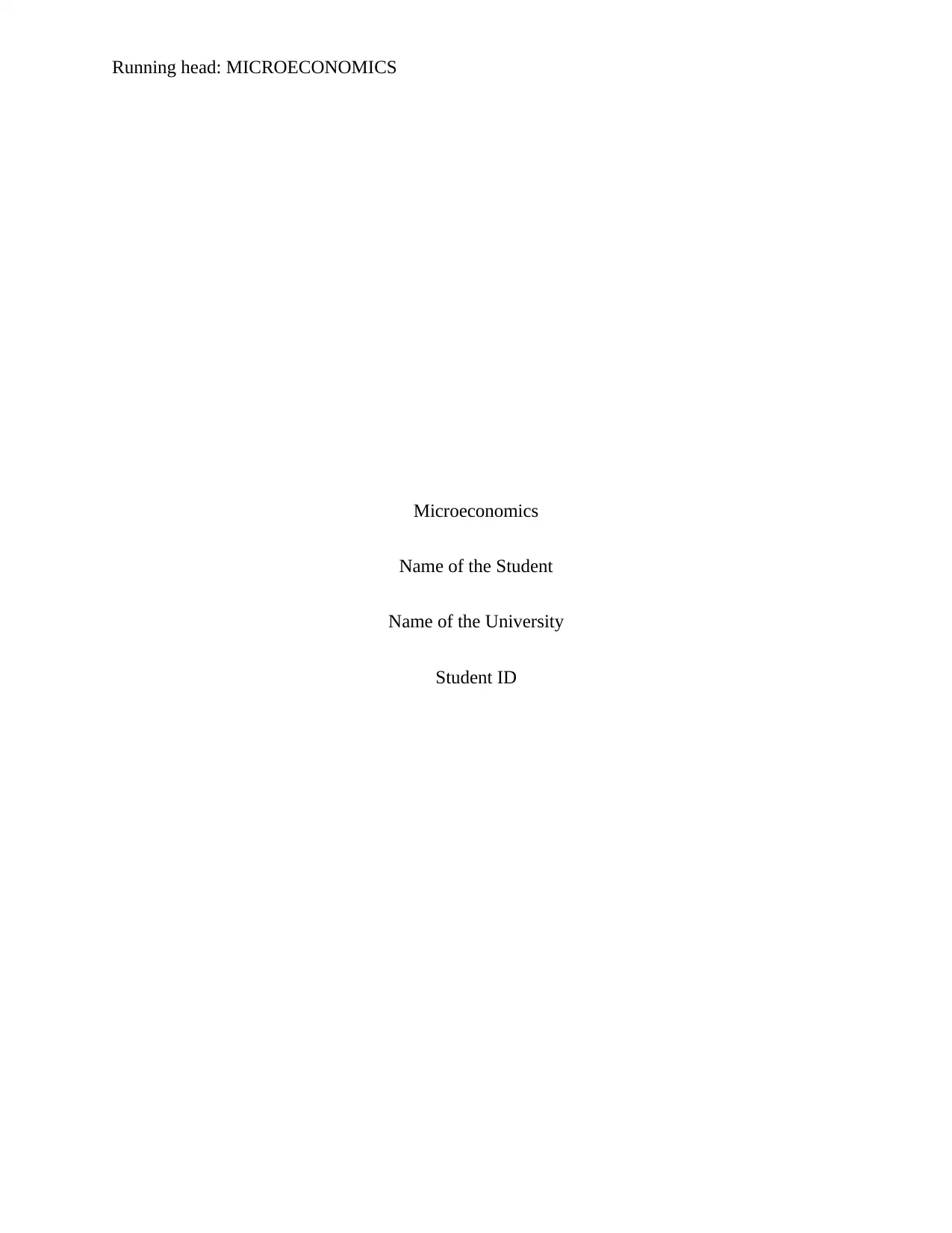
Running head: MICROECONOMICS
Microeconomics
Name of the Student
Name of the University
Student ID
Microeconomics
Name of the Student
Name of the University
Student ID
Paraphrase This Document
Need a fresh take? Get an instant paraphrase of this document with our AI Paraphraser
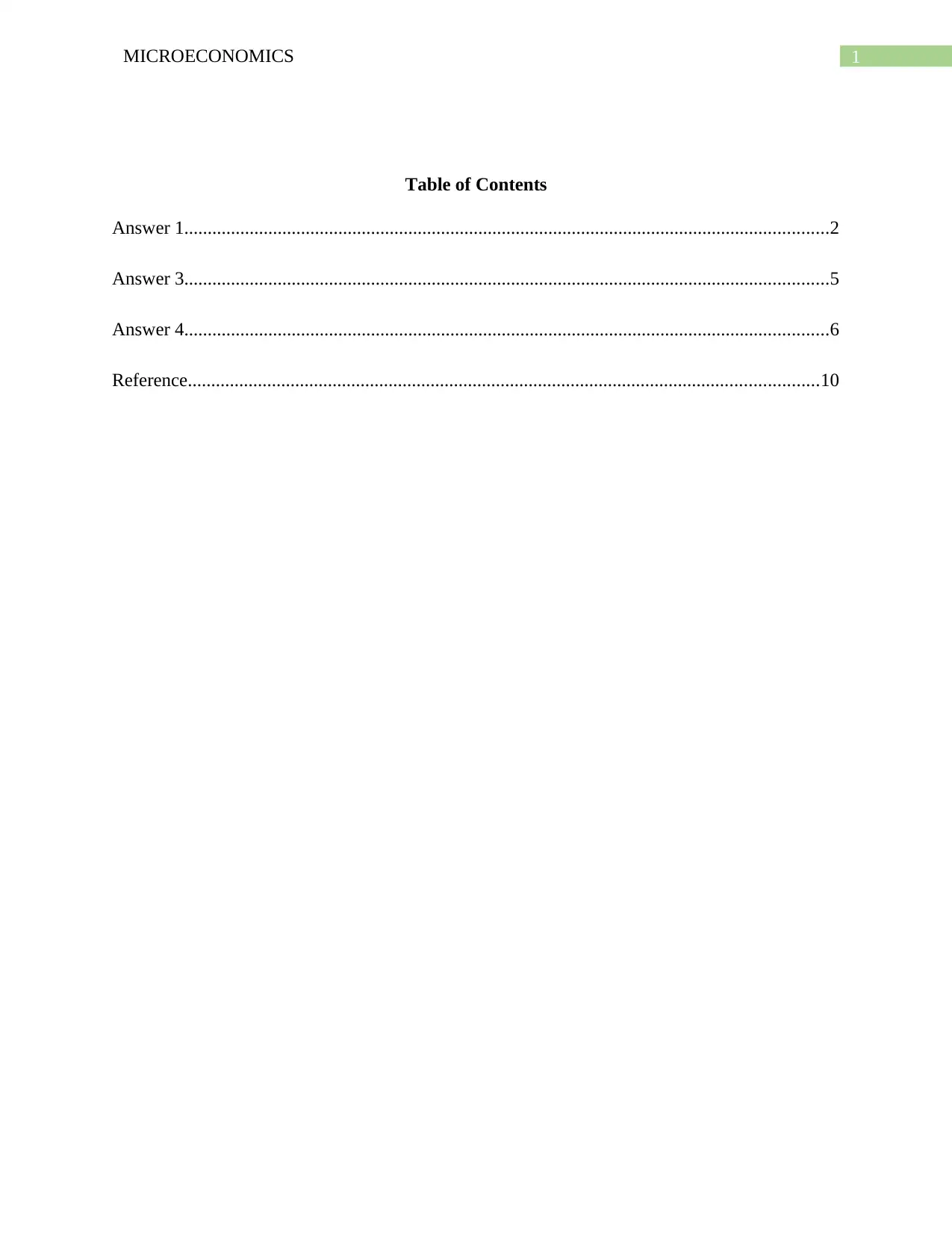
1MICROECONOMICS
Table of Contents
Answer 1..........................................................................................................................................2
Answer 3..........................................................................................................................................5
Answer 4..........................................................................................................................................6
Reference.......................................................................................................................................10
Table of Contents
Answer 1..........................................................................................................................................2
Answer 3..........................................................................................................................................5
Answer 4..........................................................................................................................................6
Reference.......................................................................................................................................10
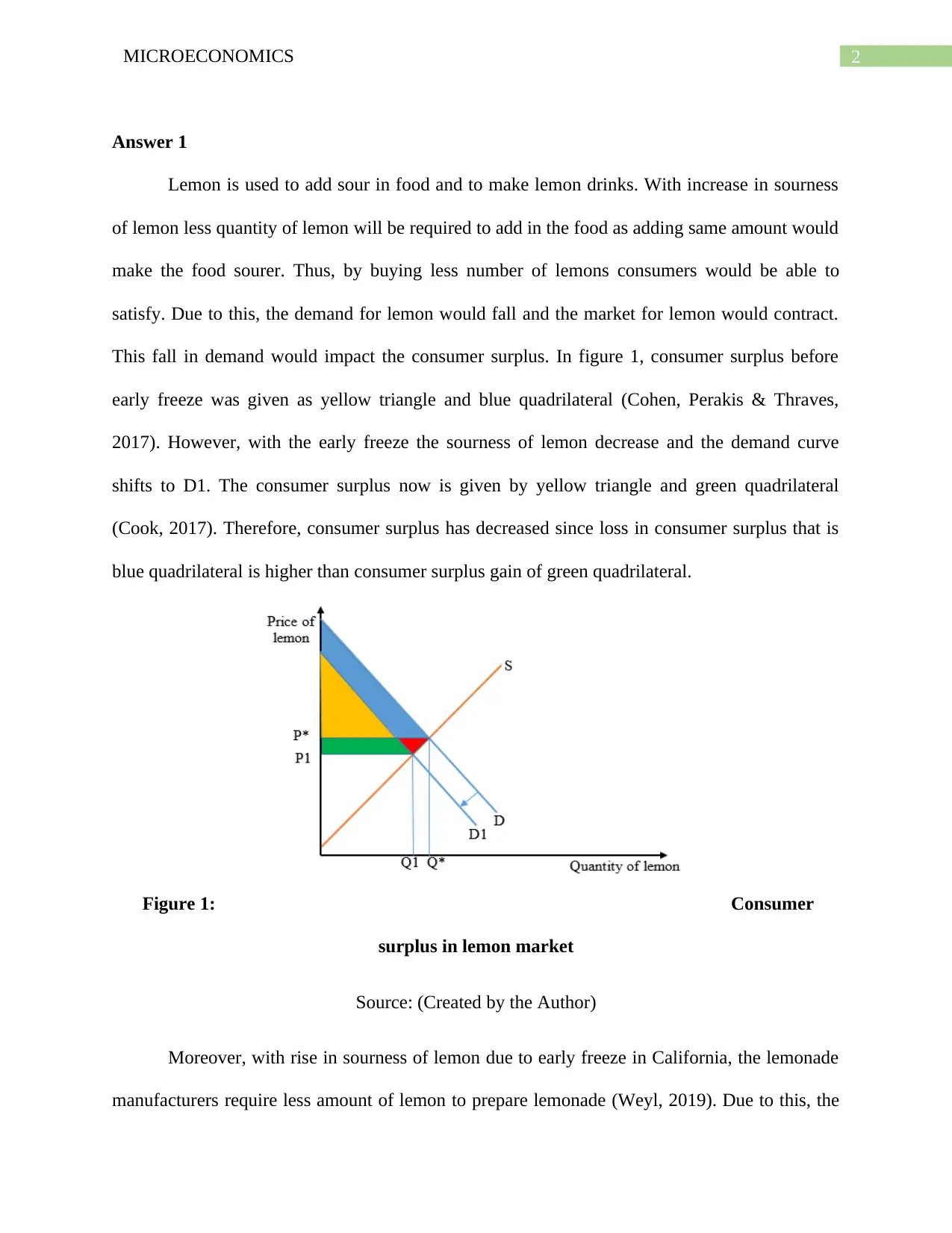
2MICROECONOMICS
Answer 1
Lemon is used to add sour in food and to make lemon drinks. With increase in sourness
of lemon less quantity of lemon will be required to add in the food as adding same amount would
make the food sourer. Thus, by buying less number of lemons consumers would be able to
satisfy. Due to this, the demand for lemon would fall and the market for lemon would contract.
This fall in demand would impact the consumer surplus. In figure 1, consumer surplus before
early freeze was given as yellow triangle and blue quadrilateral (Cohen, Perakis & Thraves,
2017). However, with the early freeze the sourness of lemon decrease and the demand curve
shifts to D1. The consumer surplus now is given by yellow triangle and green quadrilateral
(Cook, 2017). Therefore, consumer surplus has decreased since loss in consumer surplus that is
blue quadrilateral is higher than consumer surplus gain of green quadrilateral.
Figure 1: Consumer
surplus in lemon market
Source: (Created by the Author)
Moreover, with rise in sourness of lemon due to early freeze in California, the lemonade
manufacturers require less amount of lemon to prepare lemonade (Weyl, 2019). Due to this, the
Answer 1
Lemon is used to add sour in food and to make lemon drinks. With increase in sourness
of lemon less quantity of lemon will be required to add in the food as adding same amount would
make the food sourer. Thus, by buying less number of lemons consumers would be able to
satisfy. Due to this, the demand for lemon would fall and the market for lemon would contract.
This fall in demand would impact the consumer surplus. In figure 1, consumer surplus before
early freeze was given as yellow triangle and blue quadrilateral (Cohen, Perakis & Thraves,
2017). However, with the early freeze the sourness of lemon decrease and the demand curve
shifts to D1. The consumer surplus now is given by yellow triangle and green quadrilateral
(Cook, 2017). Therefore, consumer surplus has decreased since loss in consumer surplus that is
blue quadrilateral is higher than consumer surplus gain of green quadrilateral.
Figure 1: Consumer
surplus in lemon market
Source: (Created by the Author)
Moreover, with rise in sourness of lemon due to early freeze in California, the lemonade
manufacturers require less amount of lemon to prepare lemonade (Weyl, 2019). Due to this, the
⊘ This is a preview!⊘
Do you want full access?
Subscribe today to unlock all pages.

Trusted by 1+ million students worldwide
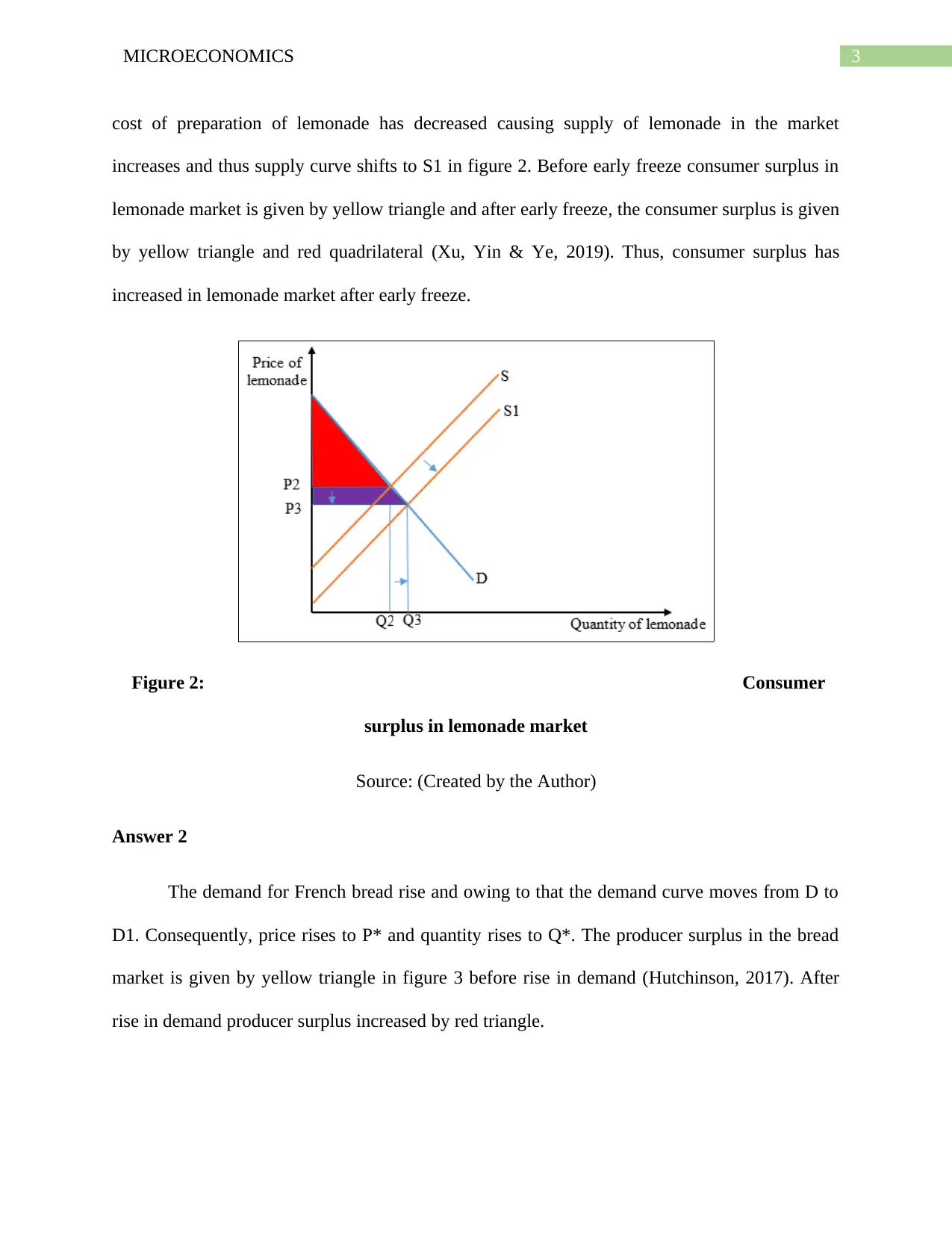
3MICROECONOMICS
cost of preparation of lemonade has decreased causing supply of lemonade in the market
increases and thus supply curve shifts to S1 in figure 2. Before early freeze consumer surplus in
lemonade market is given by yellow triangle and after early freeze, the consumer surplus is given
by yellow triangle and red quadrilateral (Xu, Yin & Ye, 2019). Thus, consumer surplus has
increased in lemonade market after early freeze.
Figure 2: Consumer
surplus in lemonade market
Source: (Created by the Author)
Answer 2
The demand for French bread rise and owing to that the demand curve moves from D to
D1. Consequently, price rises to P* and quantity rises to Q*. The producer surplus in the bread
market is given by yellow triangle in figure 3 before rise in demand (Hutchinson, 2017). After
rise in demand producer surplus increased by red triangle.
cost of preparation of lemonade has decreased causing supply of lemonade in the market
increases and thus supply curve shifts to S1 in figure 2. Before early freeze consumer surplus in
lemonade market is given by yellow triangle and after early freeze, the consumer surplus is given
by yellow triangle and red quadrilateral (Xu, Yin & Ye, 2019). Thus, consumer surplus has
increased in lemonade market after early freeze.
Figure 2: Consumer
surplus in lemonade market
Source: (Created by the Author)
Answer 2
The demand for French bread rise and owing to that the demand curve moves from D to
D1. Consequently, price rises to P* and quantity rises to Q*. The producer surplus in the bread
market is given by yellow triangle in figure 3 before rise in demand (Hutchinson, 2017). After
rise in demand producer surplus increased by red triangle.
Paraphrase This Document
Need a fresh take? Get an instant paraphrase of this document with our AI Paraphraser
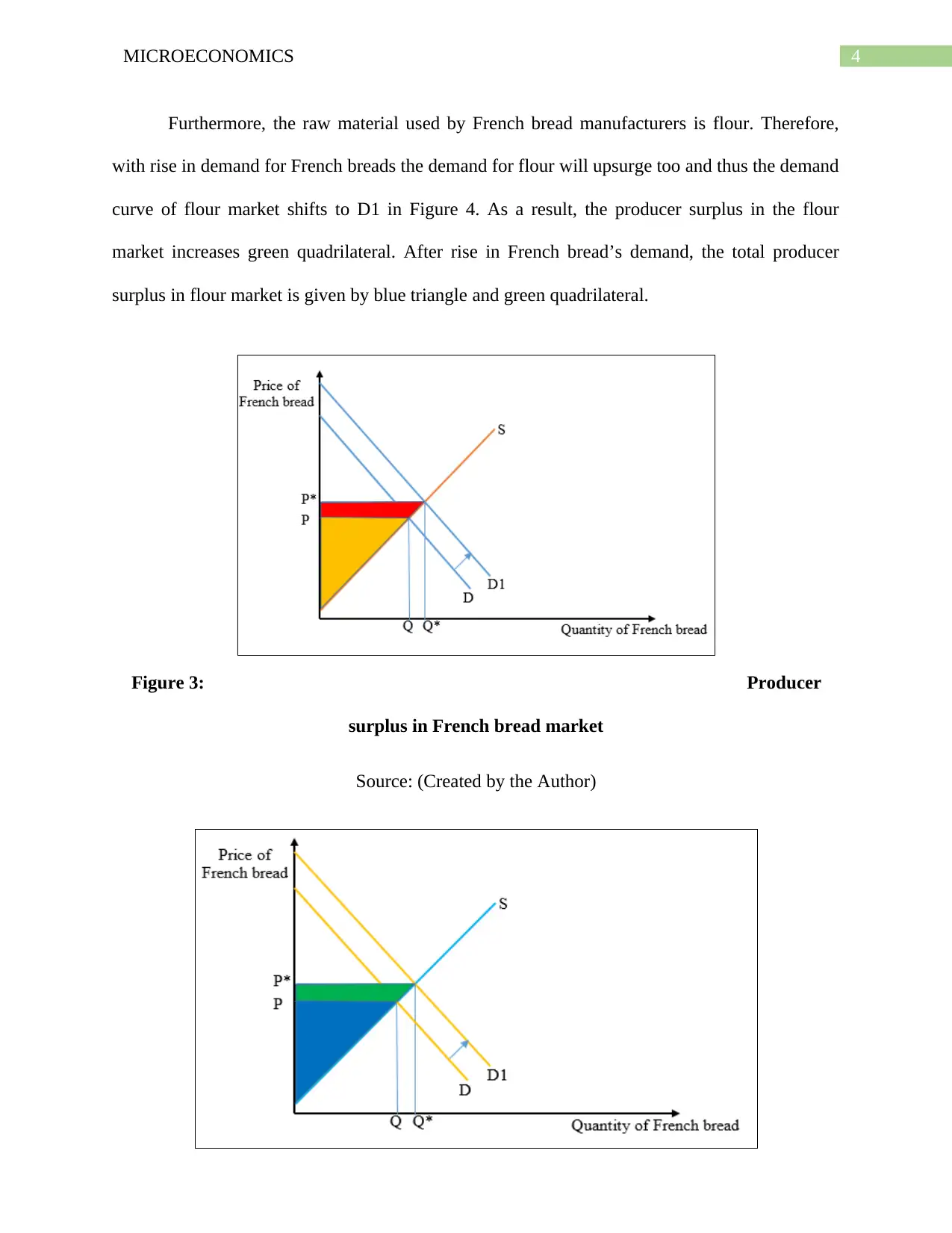
4MICROECONOMICS
Furthermore, the raw material used by French bread manufacturers is flour. Therefore,
with rise in demand for French breads the demand for flour will upsurge too and thus the demand
curve of flour market shifts to D1 in Figure 4. As a result, the producer surplus in the flour
market increases green quadrilateral. After rise in French bread’s demand, the total producer
surplus in flour market is given by blue triangle and green quadrilateral.
Figure 3: Producer
surplus in French bread market
Source: (Created by the Author)
Furthermore, the raw material used by French bread manufacturers is flour. Therefore,
with rise in demand for French breads the demand for flour will upsurge too and thus the demand
curve of flour market shifts to D1 in Figure 4. As a result, the producer surplus in the flour
market increases green quadrilateral. After rise in French bread’s demand, the total producer
surplus in flour market is given by blue triangle and green quadrilateral.
Figure 3: Producer
surplus in French bread market
Source: (Created by the Author)
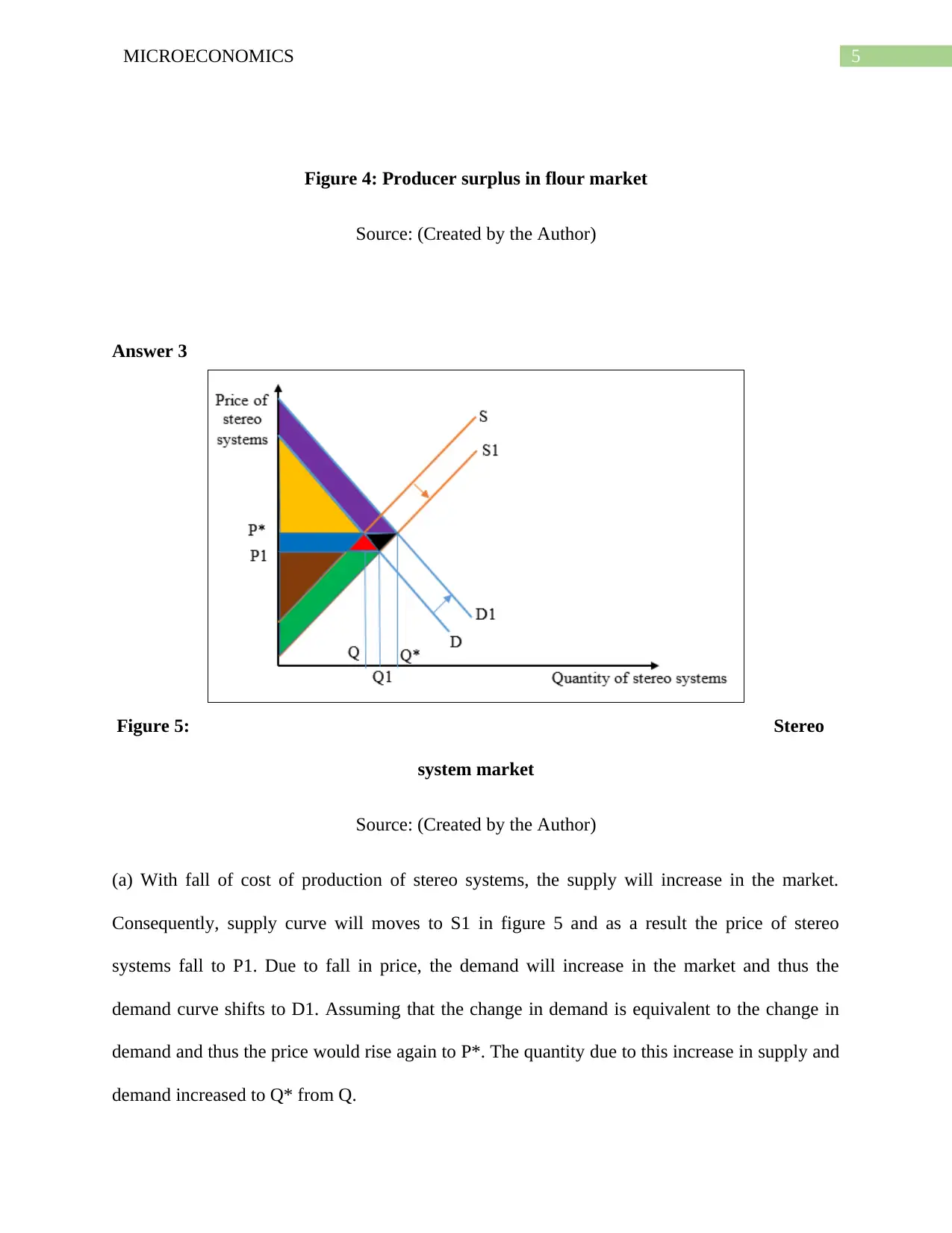
5MICROECONOMICS
Figure 4: Producer surplus in flour market
Source: (Created by the Author)
Answer 3
Figure 5: Stereo
system market
Source: (Created by the Author)
(a) With fall of cost of production of stereo systems, the supply will increase in the market.
Consequently, supply curve will moves to S1 in figure 5 and as a result the price of stereo
systems fall to P1. Due to fall in price, the demand will increase in the market and thus the
demand curve shifts to D1. Assuming that the change in demand is equivalent to the change in
demand and thus the price would rise again to P*. The quantity due to this increase in supply and
demand increased to Q* from Q.
Figure 4: Producer surplus in flour market
Source: (Created by the Author)
Answer 3
Figure 5: Stereo
system market
Source: (Created by the Author)
(a) With fall of cost of production of stereo systems, the supply will increase in the market.
Consequently, supply curve will moves to S1 in figure 5 and as a result the price of stereo
systems fall to P1. Due to fall in price, the demand will increase in the market and thus the
demand curve shifts to D1. Assuming that the change in demand is equivalent to the change in
demand and thus the price would rise again to P*. The quantity due to this increase in supply and
demand increased to Q* from Q.
⊘ This is a preview!⊘
Do you want full access?
Subscribe today to unlock all pages.

Trusted by 1+ million students worldwide
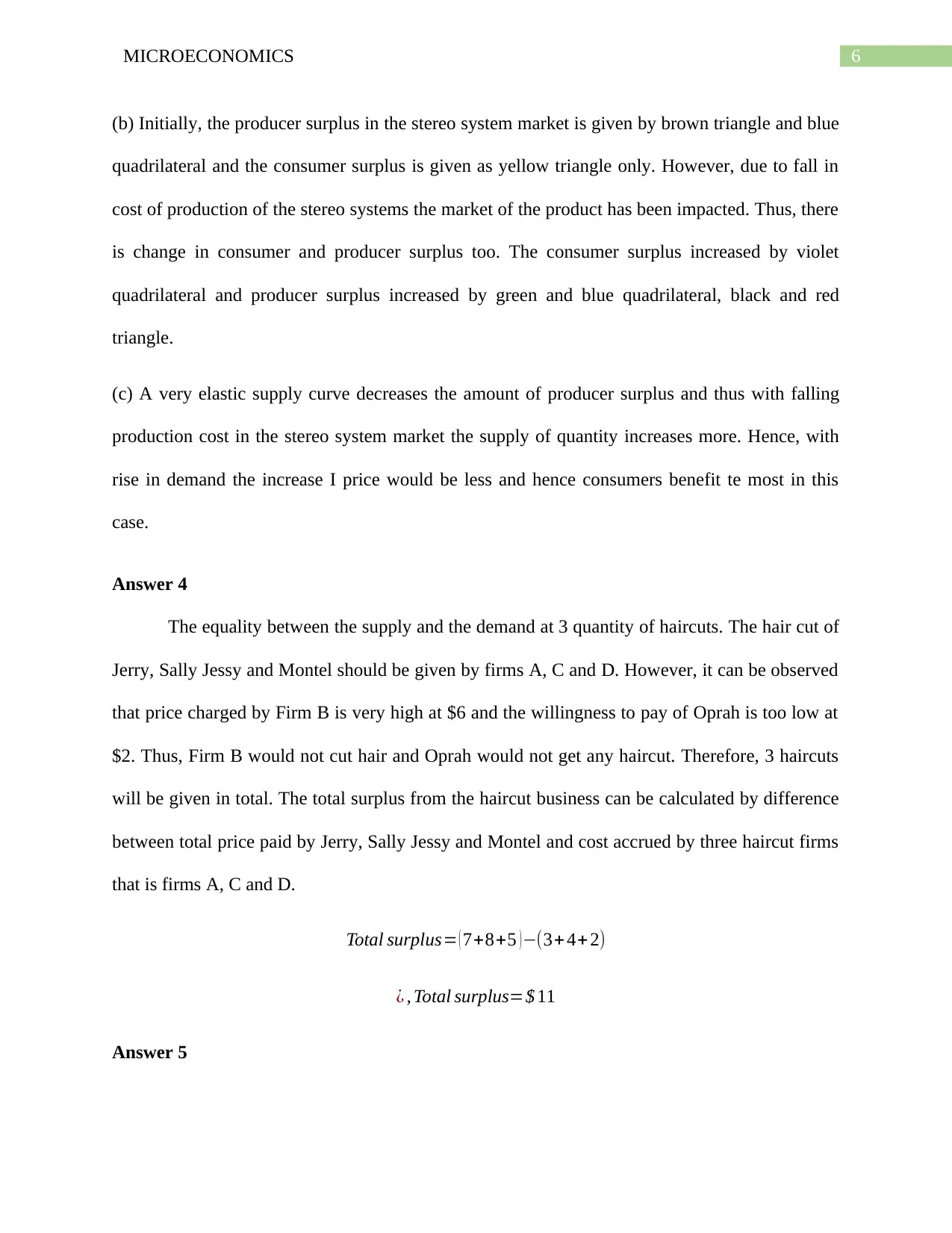
6MICROECONOMICS
(b) Initially, the producer surplus in the stereo system market is given by brown triangle and blue
quadrilateral and the consumer surplus is given as yellow triangle only. However, due to fall in
cost of production of the stereo systems the market of the product has been impacted. Thus, there
is change in consumer and producer surplus too. The consumer surplus increased by violet
quadrilateral and producer surplus increased by green and blue quadrilateral, black and red
triangle.
(c) A very elastic supply curve decreases the amount of producer surplus and thus with falling
production cost in the stereo system market the supply of quantity increases more. Hence, with
rise in demand the increase I price would be less and hence consumers benefit te most in this
case.
Answer 4
The equality between the supply and the demand at 3 quantity of haircuts. The hair cut of
Jerry, Sally Jessy and Montel should be given by firms A, C and D. However, it can be observed
that price charged by Firm B is very high at $6 and the willingness to pay of Oprah is too low at
$2. Thus, Firm B would not cut hair and Oprah would not get any haircut. Therefore, 3 haircuts
will be given in total. The total surplus from the haircut business can be calculated by difference
between total price paid by Jerry, Sally Jessy and Montel and cost accrued by three haircut firms
that is firms A, C and D.
Total surplus= ( 7+8+5 ) −(3+ 4+ 2)
¿ , Total surplus=$ 11
Answer 5
(b) Initially, the producer surplus in the stereo system market is given by brown triangle and blue
quadrilateral and the consumer surplus is given as yellow triangle only. However, due to fall in
cost of production of the stereo systems the market of the product has been impacted. Thus, there
is change in consumer and producer surplus too. The consumer surplus increased by violet
quadrilateral and producer surplus increased by green and blue quadrilateral, black and red
triangle.
(c) A very elastic supply curve decreases the amount of producer surplus and thus with falling
production cost in the stereo system market the supply of quantity increases more. Hence, with
rise in demand the increase I price would be less and hence consumers benefit te most in this
case.
Answer 4
The equality between the supply and the demand at 3 quantity of haircuts. The hair cut of
Jerry, Sally Jessy and Montel should be given by firms A, C and D. However, it can be observed
that price charged by Firm B is very high at $6 and the willingness to pay of Oprah is too low at
$2. Thus, Firm B would not cut hair and Oprah would not get any haircut. Therefore, 3 haircuts
will be given in total. The total surplus from the haircut business can be calculated by difference
between total price paid by Jerry, Sally Jessy and Montel and cost accrued by three haircut firms
that is firms A, C and D.
Total surplus= ( 7+8+5 ) −(3+ 4+ 2)
¿ , Total surplus=$ 11
Answer 5
Paraphrase This Document
Need a fresh take? Get an instant paraphrase of this document with our AI Paraphraser
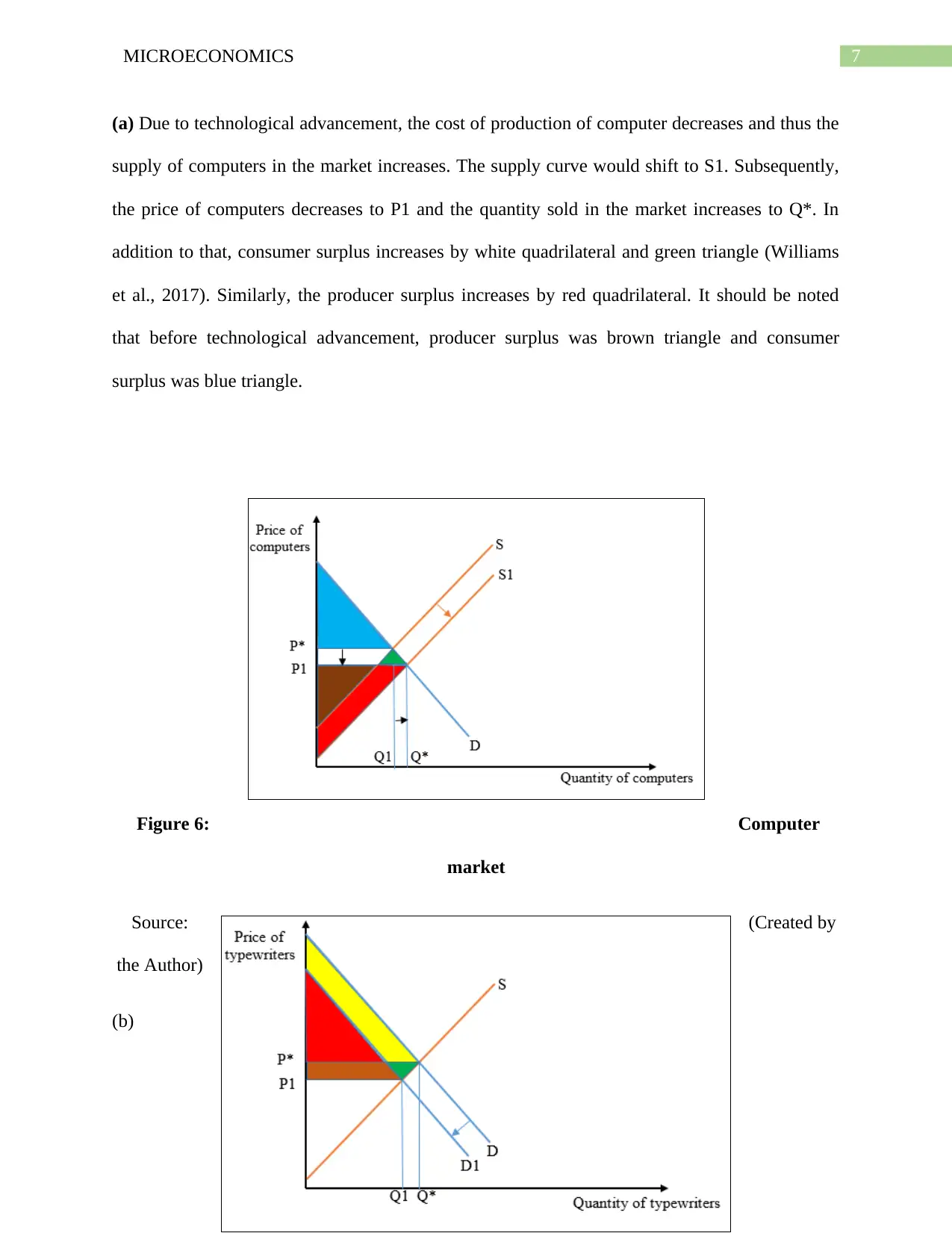
7MICROECONOMICS
(a) Due to technological advancement, the cost of production of computer decreases and thus the
supply of computers in the market increases. The supply curve would shift to S1. Subsequently,
the price of computers decreases to P1 and the quantity sold in the market increases to Q*. In
addition to that, consumer surplus increases by white quadrilateral and green triangle (Williams
et al., 2017). Similarly, the producer surplus increases by red quadrilateral. It should be noted
that before technological advancement, producer surplus was brown triangle and consumer
surplus was blue triangle.
Figure 6: Computer
market
Source: (Created by
the Author)
(b)
(a) Due to technological advancement, the cost of production of computer decreases and thus the
supply of computers in the market increases. The supply curve would shift to S1. Subsequently,
the price of computers decreases to P1 and the quantity sold in the market increases to Q*. In
addition to that, consumer surplus increases by white quadrilateral and green triangle (Williams
et al., 2017). Similarly, the producer surplus increases by red quadrilateral. It should be noted
that before technological advancement, producer surplus was brown triangle and consumer
surplus was blue triangle.
Figure 6: Computer
market
Source: (Created by
the Author)
(b)
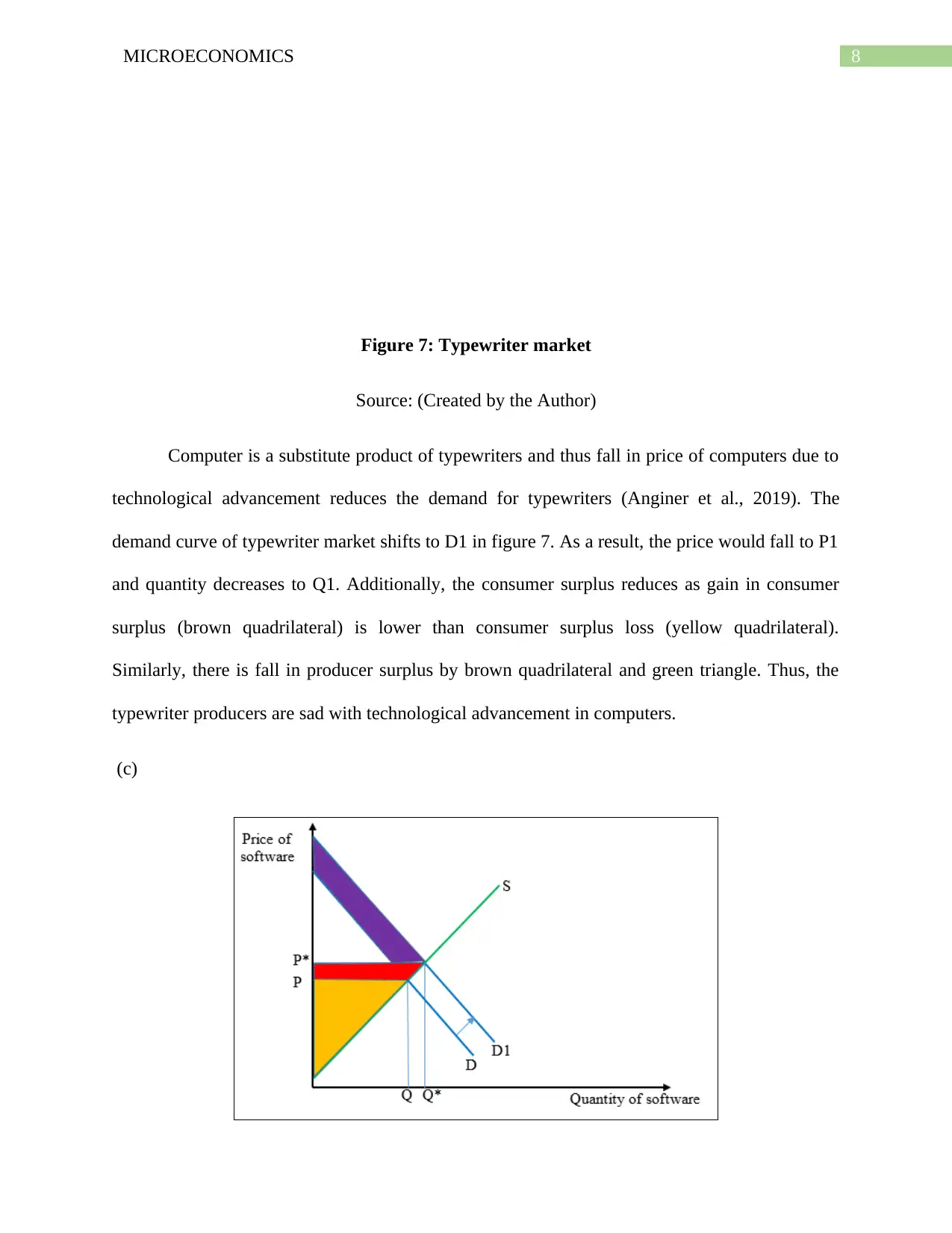
8MICROECONOMICS
Figure 7: Typewriter market
Source: (Created by the Author)
Computer is a substitute product of typewriters and thus fall in price of computers due to
technological advancement reduces the demand for typewriters (Anginer et al., 2019). The
demand curve of typewriter market shifts to D1 in figure 7. As a result, the price would fall to P1
and quantity decreases to Q1. Additionally, the consumer surplus reduces as gain in consumer
surplus (brown quadrilateral) is lower than consumer surplus loss (yellow quadrilateral).
Similarly, there is fall in producer surplus by brown quadrilateral and green triangle. Thus, the
typewriter producers are sad with technological advancement in computers.
(c)
Figure 7: Typewriter market
Source: (Created by the Author)
Computer is a substitute product of typewriters and thus fall in price of computers due to
technological advancement reduces the demand for typewriters (Anginer et al., 2019). The
demand curve of typewriter market shifts to D1 in figure 7. As a result, the price would fall to P1
and quantity decreases to Q1. Additionally, the consumer surplus reduces as gain in consumer
surplus (brown quadrilateral) is lower than consumer surplus loss (yellow quadrilateral).
Similarly, there is fall in producer surplus by brown quadrilateral and green triangle. Thus, the
typewriter producers are sad with technological advancement in computers.
(c)
⊘ This is a preview!⊘
Do you want full access?
Subscribe today to unlock all pages.

Trusted by 1+ million students worldwide
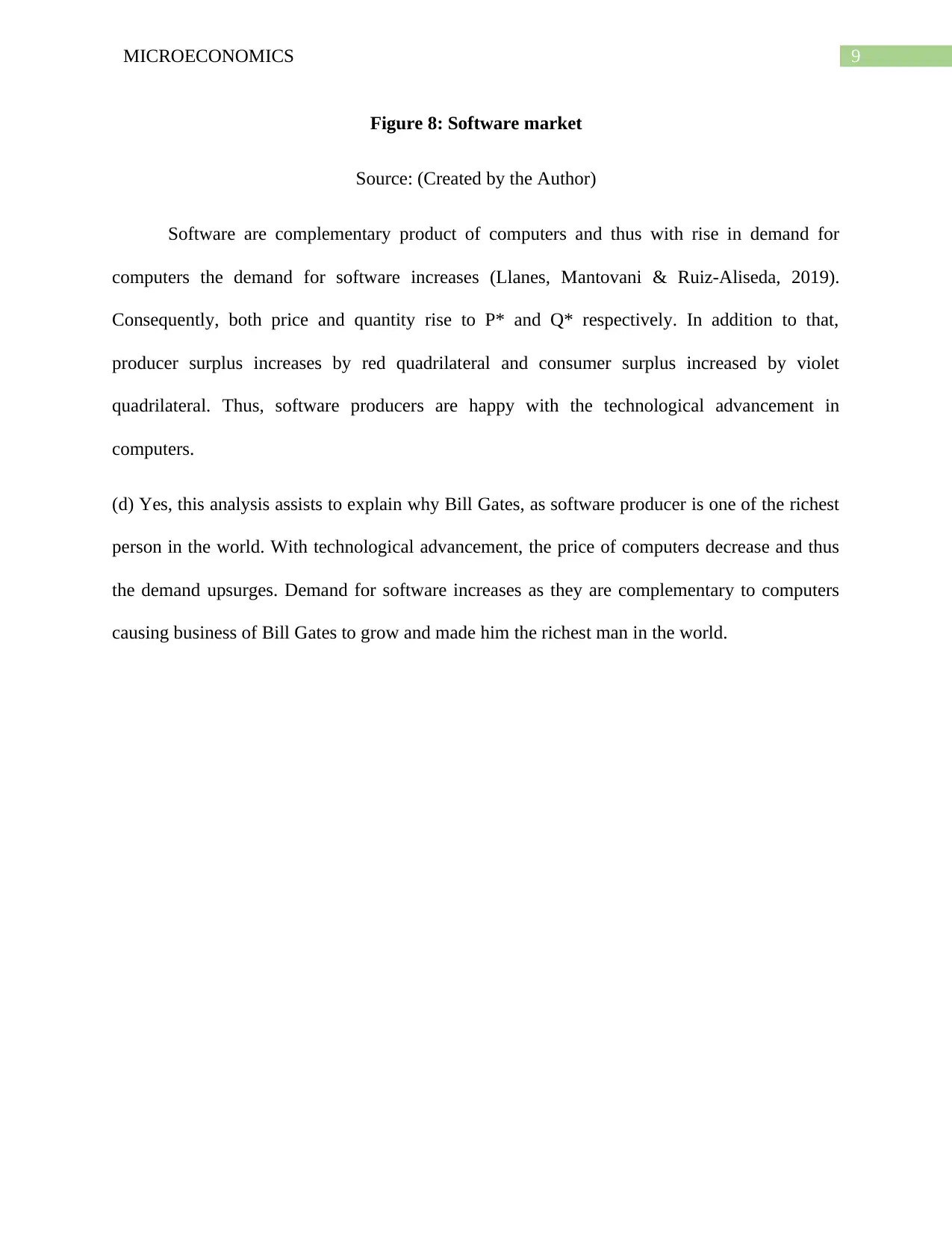
9MICROECONOMICS
Figure 8: Software market
Source: (Created by the Author)
Software are complementary product of computers and thus with rise in demand for
computers the demand for software increases (Llanes, Mantovani & Ruiz-Aliseda, 2019).
Consequently, both price and quantity rise to P* and Q* respectively. In addition to that,
producer surplus increases by red quadrilateral and consumer surplus increased by violet
quadrilateral. Thus, software producers are happy with the technological advancement in
computers.
(d) Yes, this analysis assists to explain why Bill Gates, as software producer is one of the richest
person in the world. With technological advancement, the price of computers decrease and thus
the demand upsurges. Demand for software increases as they are complementary to computers
causing business of Bill Gates to grow and made him the richest man in the world.
Figure 8: Software market
Source: (Created by the Author)
Software are complementary product of computers and thus with rise in demand for
computers the demand for software increases (Llanes, Mantovani & Ruiz-Aliseda, 2019).
Consequently, both price and quantity rise to P* and Q* respectively. In addition to that,
producer surplus increases by red quadrilateral and consumer surplus increased by violet
quadrilateral. Thus, software producers are happy with the technological advancement in
computers.
(d) Yes, this analysis assists to explain why Bill Gates, as software producer is one of the richest
person in the world. With technological advancement, the price of computers decrease and thus
the demand upsurges. Demand for software increases as they are complementary to computers
causing business of Bill Gates to grow and made him the richest man in the world.
Paraphrase This Document
Need a fresh take? Get an instant paraphrase of this document with our AI Paraphraser
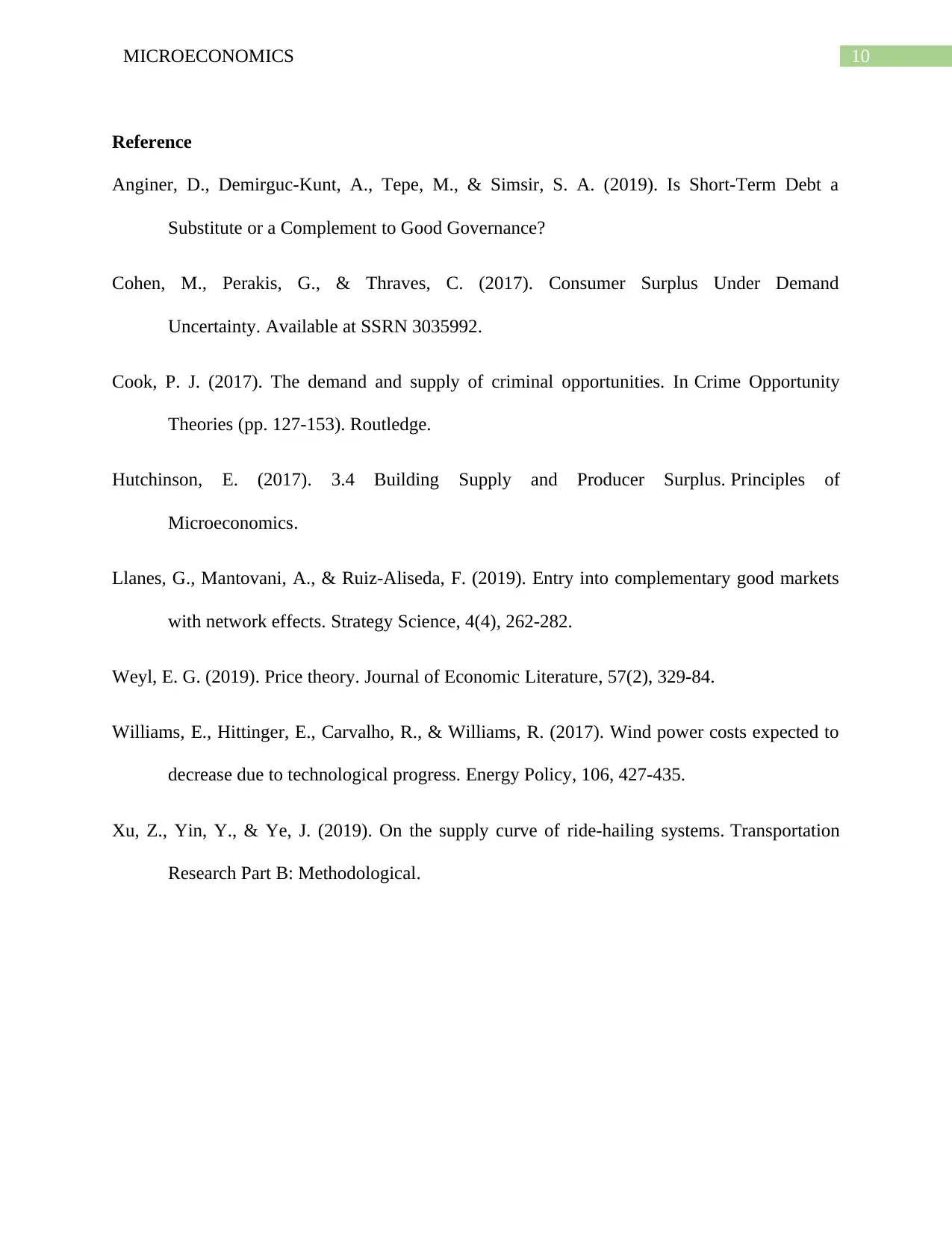
10MICROECONOMICS
Reference
Anginer, D., Demirguc-Kunt, A., Tepe, M., & Simsir, S. A. (2019). Is Short-Term Debt a
Substitute or a Complement to Good Governance?
Cohen, M., Perakis, G., & Thraves, C. (2017). Consumer Surplus Under Demand
Uncertainty. Available at SSRN 3035992.
Cook, P. J. (2017). The demand and supply of criminal opportunities. In Crime Opportunity
Theories (pp. 127-153). Routledge.
Hutchinson, E. (2017). 3.4 Building Supply and Producer Surplus. Principles of
Microeconomics.
Llanes, G., Mantovani, A., & Ruiz-Aliseda, F. (2019). Entry into complementary good markets
with network effects. Strategy Science, 4(4), 262-282.
Weyl, E. G. (2019). Price theory. Journal of Economic Literature, 57(2), 329-84.
Williams, E., Hittinger, E., Carvalho, R., & Williams, R. (2017). Wind power costs expected to
decrease due to technological progress. Energy Policy, 106, 427-435.
Xu, Z., Yin, Y., & Ye, J. (2019). On the supply curve of ride-hailing systems. Transportation
Research Part B: Methodological.
Reference
Anginer, D., Demirguc-Kunt, A., Tepe, M., & Simsir, S. A. (2019). Is Short-Term Debt a
Substitute or a Complement to Good Governance?
Cohen, M., Perakis, G., & Thraves, C. (2017). Consumer Surplus Under Demand
Uncertainty. Available at SSRN 3035992.
Cook, P. J. (2017). The demand and supply of criminal opportunities. In Crime Opportunity
Theories (pp. 127-153). Routledge.
Hutchinson, E. (2017). 3.4 Building Supply and Producer Surplus. Principles of
Microeconomics.
Llanes, G., Mantovani, A., & Ruiz-Aliseda, F. (2019). Entry into complementary good markets
with network effects. Strategy Science, 4(4), 262-282.
Weyl, E. G. (2019). Price theory. Journal of Economic Literature, 57(2), 329-84.
Williams, E., Hittinger, E., Carvalho, R., & Williams, R. (2017). Wind power costs expected to
decrease due to technological progress. Energy Policy, 106, 427-435.
Xu, Z., Yin, Y., & Ye, J. (2019). On the supply curve of ride-hailing systems. Transportation
Research Part B: Methodological.
1 out of 11
Related Documents
Your All-in-One AI-Powered Toolkit for Academic Success.
+13062052269
info@desklib.com
Available 24*7 on WhatsApp / Email
![[object Object]](/_next/static/media/star-bottom.7253800d.svg)
Unlock your academic potential
Copyright © 2020–2025 A2Z Services. All Rights Reserved. Developed and managed by ZUCOL.





